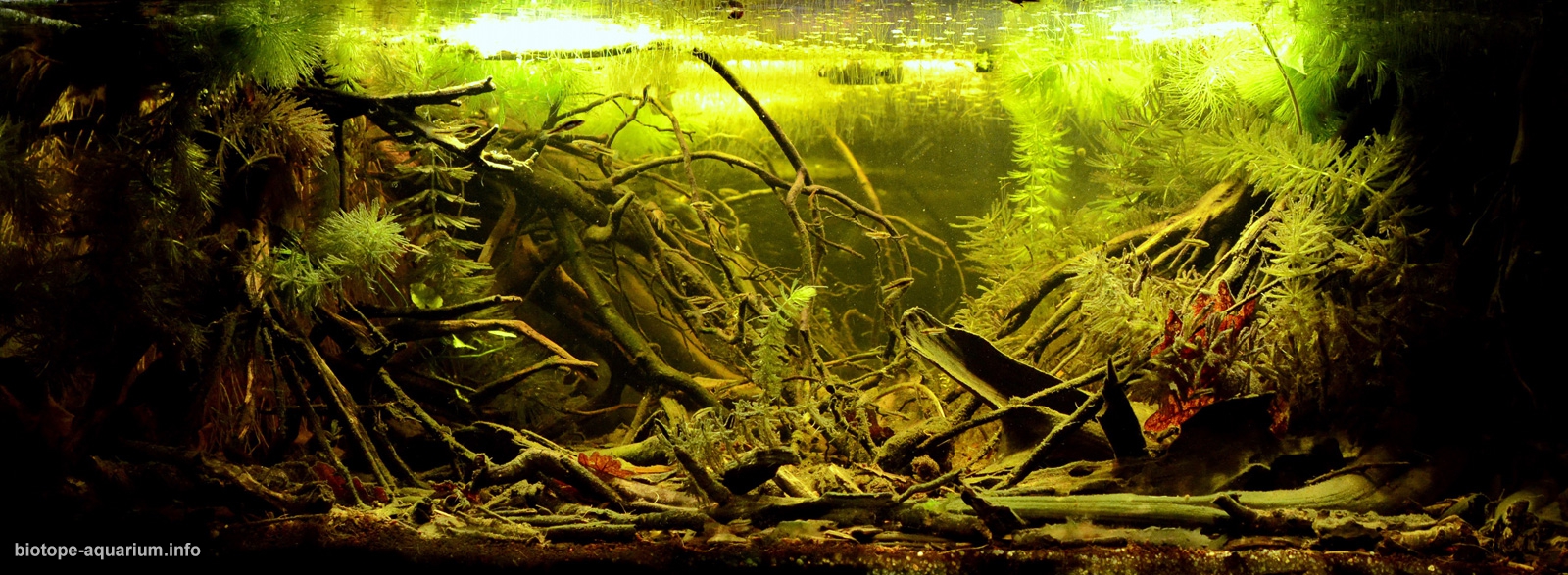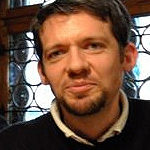Small stream in Choctaw National Wildlife Refuge, Alabama, USA
11th place in Biotope Aquarium Design Contest 2018
![]() Poland. Dominik Woroch
Poland. Dominik Woroch

Volume: 96 L
Dimensions: 80x40x30 cm
List of fishes: Heterandria formosa, Cambarellus diminutus
List of plants: Ceratophyllum demersum, Hydrocotyle leucocephala
Description of decorations: In the reservoir I wanted to recreate the cross-section of the forest stream. On both sides of the aquarium I have placed roots and branches imitating such as occur in nature. At the bottom I scattered the sand of different gradations, and a large amount of leaves, sticks and organic matter.
Description of equipment: Aquael VERSAMAX, 3x Aquael Leddy Tube 6W.
Water parameters: Temperature is 24°C, pH is 7,5, GH is 14, TDS is 350.
INFORMATION ABOUT BIOTOPE
Description of the area surrounding the biotope: The Choctaw National Wildlife Refuge is located in southwest Alabama along the Tombigbee River approximately 80 miles north of Mobile. The Refuge was established in 1964 on lands acquired by the Corp of Engineers in conjunction with the Coffeeville Lock and Dam project. The 4,218 acre refuge encompasses approximately 1,802 acres of lakes, sloughs, and creeks, 2,265 acres of bottomland hardwoods, and 151 acres of croplands and moist soil units. The main river reserve is the Tombigbee River. The Tombigbee River is a tributary of the Mobile River, approximately 325 km long, in the U.S. states of Mississippi and Alabama. These waters, and the hardwood bottomlands and open fields around them, draw a wealth of wildlife species, from American alligators to Anhingas. Refuge managers provide habitat and protection for threatened and endangered species, like the Wood Stork and Bald Eagle, and promote wildlife diversity, wildlife-dependent recreation, habitat for wintering waterfowl, and Wood Duck production and banding.
Description of the underwater landscape of the biotope: The biotope specified in my aquarium shows a cross-section through tiles, about 30 cm stream. The stream flows through heavily wooded areas, so the bottom is littered with fallen leaves, branches and roots. Surrounding forests are the main source of plankton and other natural foods necessary for fish and crayfish. The amount of biological mass is very high. The substrate is muddy, the stones are unlikely to occur. The water has a slightly brown color.
Description of the parameters of the habitat: Transparent water, temperature from 5 degrees in winter to 26 degrees in summer. Ph varies between 6.8 and 8.1. TDS is high.
List of fishes and invertebrates occurring in the nature biotope: Ictalurus furcatus, Micropterus salmoides, Acipenser oxyrhynchus desotoi, Etheostoma nuchale, Moxostoma duquesnii, Heterandria formosa, Cyprinella callistia, Percina sciera, Semotilus thoreauianus, Cambarellus Diminutus, Elassoma evergladei.
List of plants found in the nature biotope: Vallisneria spiralis L, Echinodorus Cordifolius, Vallisneria americana, Hydrocotyle leucocephala, Cabomba caroliniana, Myriophyllum Spicatum, Ceratophyllum demersum, Myriophyllum Verticillatum, Hydrocotyle Verticillata, Sagittaria Platyphylla, Lemna minor, Taxiphyllum sp., Ludwigia repens, Bacopa monnieri, Hydrocotyle leucocephala.
Sources of information:
https://www.fws.gov/choctaw/,
https://en.wikipedia.org/wiki/Choctaw_National_Wildlife_Refuge,
https://en.wikipedia.org/wiki/Tombigbee_River,
https://waterdata.usgs.gov/nwis/uv/?site_no=02469100,
http://www.adem.alabama.gov/programs/water/wqsurvey/2001IntensiveWQSTombigbee.pdf,
http://www.encyclopediaofalabama.org/article/h-1586,
http://fishbase.org,
http://www.tropicos.org,
Aquarium inspired by nature – Hiscock Peter,
https://www.google.pl/maps/@31.7859656,-88.2375254,3a,75y,121.86h,73.52t/data=!3m6!1e1!3m4!1sSa0GxizVtcFC3ZqAjHFU3A!2e0!7i13312!8i6656
Comments of the members of the jury of Biotope Aquarium Design Contest 2018

This is the one of most natural looking aquariums in this competition but it does not mean that it is most beautiful. You used too much materials therefore your tank looks bigger. I liked the naturalness here but this aquarium could be designed better. Your lights support naturalness very well. I liked your species choice for this biotope. Video, photos and information is enough. Still good job, congrats.

Proof that a biotope does not need to be large to be roomy! A well-planned balance of open space for the fish and complex surface area for the crayfish allows swimming room and social interaction for the former while affording territorial boundaries and caves for the latter. A couple of the crayfish have missing claws, but this happens rather easily so I did not assume this was from aggressive interactions. There is a feeling of teeming life, with the myriad tiny fish flitting about while the crayfish scuttle over every surface. The rough-around-the-edges quality to this work is provided by the messy tangle of organic debris, all coated in a fine fuzz of algal growth, with aquatic plants growing up through the roots just as they would in the wild. It is an extremely charming little biotope.
